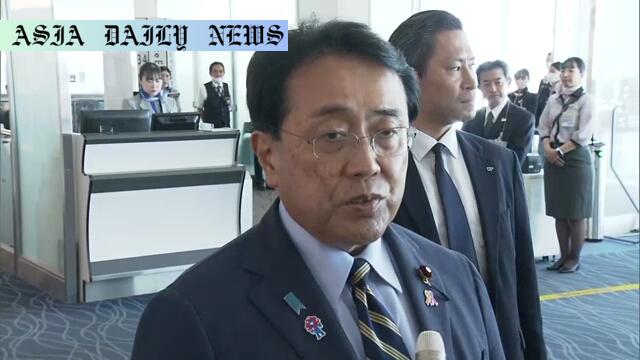Tariffs negotiation heats up as Japan’s Akazawa Ryosei heads to Washington to discuss July 25% reciprocal imports tariff.
Japan’s Akazawa Ryosei embarks on his 8th trip for US tariff talks.
US is set to impose a 25% tariff on Japanese imports on August 1.
Discussions to cover investments and trade balance proposals.

Overview of Japan’s Tariff Negotiations with the US
With the looming threat of a 25-percent tariff on Japanese imports into the United States, Japan has deployed its top negotiator, Economic Revitalization Minister Akazawa Ryosei, to Washington. This marks Akazawa’s eighth trip aimed at resolving what many consider to be one of the most pivotal economic disputes between the two nations in recent years. Departing Tokyo on Monday, Akazawa emphasized the challenges ahead, portraying the negotiations as a delicate balancing act of safeguarding national interests while striving for common ground. His diplomatic effort comes ahead of the critical August 1 deadline, when the tariffs—described by U.S. President Donald Trump as “reciprocal”—are slated to take effect.
The Core Issues Behind the Tariff Dispute
At the heart of the ongoing tension are concerns surrounding the United States’ trade deficit with Japan. As one of its largest trade partners, Japan has long served as a significant exporter of automobiles, electronics, and other goods to the American market. Washington, in turn, argues that this trade imbalance puts the U.S. in a disadvantaged position economically. As part of efforts to bridge the gap, Tokyo has proposed massive investments into the American economy, alongside commitments to import more U.S. goods. These measures are under review by the U.S., with the outcome of discussions poised to significantly influence bilateral trade dynamics and economic policies for both nations.
Meetings Slated with Senior US Officials
During his Washington visit, Akazawa is expected to engage in high-stakes discussions with Secretary of Commerce Howard Lutnick, Treasury Secretary Scott Bessent, and U.S. Trade Representative Jamieson Greer. These meetings will likely focus on Japan’s investment and import proposals, as well as explore pathways to minimize economic disruptions caused by tariff impositions. Japanese officials have expressed optimism in forging a mutually beneficial agreement, though the complexities of the issues at hand—ranging from industry-specific disputes to broader economic principles—underscore the difficulty of a swift resolution. Given the tight timeline, stakeholders on both sides are watching the negotiations closely.
Potential Implications of the August 1 Deadline
Should an agreement fail to materialize by the August 1 deadline, the imposition of 25-percent tariffs on Japanese imports could significantly alter the economic relationship between two of the world’s largest economies. For consumers in the U.S., these tariffs may translate into higher prices on Japanese goods, impacting everything from vehicles to consumer electronics. Conversely, Japan’s export-reliant industries could face substantial losses, potentially weakening its economy at a time when global economic conditions already present challenges. The ripple effects might extend to other nations as well, influencing global trade patterns and economic alliances.
Looking Ahead: Can Diplomacy Bridge the Divide?
As talks progress, the key question remains: can diplomacy reconcile the differing priorities and demands of both nations? While both Japan and the U.S. have much to gain from reaching a mutually beneficial agreement, navigating the intricacies of trade policies and national interests requires careful, skillful negotiation. The stakes are high not only for policymakers and governments but also for businesses, consumers, and the broader global economy. With Akazawa spearheading Japan’s efforts and the U.S. reviewing Tokyo’s proposals, the coming days will be a critical test of bilateral cooperation and economic diplomacy.



Commentary
The Rising Importance of Diplomatic Negotiations
The unfolding tariff dispute between Japan and the United States serves as a stark reminder of how intertwined global economies have become—and how fragile these ties can be amidst political shifts. Japan, known for its robust trade strategy and industrial output, faces a pivotal point in its negotiations with the U.S., one of its most significant trade partners. As tariffs threaten to disrupt this relationship, Akazawa Ryosei’s efforts symbolize Japan’s commitment to maintaining economic stability while safeguarding its national interests. The ability to strike a balance between reducing the trade deficit and upholding national economic policies will shape the future trajectory of the two nations.
The Complexity of Balancing Interests
One cannot overlook how challenging it is to align the interests of two major economies, each driven by a different set of policies, priorities, and public expectations. For the U.S., the trade deficit is a critical issue that directly ties into its broader economic objectives. For Japan, however, the longevity and prosperity of its export-driven industries are paramount. Discussions surrounding increased investment and heightened imports from the U.S. might offer a temporary solution, but they are unlikely to address the systemic challenges at the root of the trade imbalance. This underscores the need for a long-term vision, one that takes into account evolving global economic trends and technological advancements.
The Global Impacts of Tariff Talks
Global trade policies have far-reaching implications, not just for the countries directly involved but for the entire international community. Tariff impositions can create ripples across industries, altering supply chains and driving up costs for businesses and consumers alike. More importantly, disputes like this highlight the fragility of multilateral trade agreements and institutions. While Japan and the U.S. strive to resolve their differences, the eventual outcome of these talks could set a precedent for other nations grappling with similar issues, reinforcing the need for collaborative solutions to shared challenges.